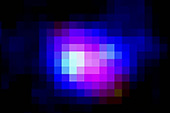A giant space blob discovered in the far reaches of the universe has scientists puzzling over what exactly the bizarre object might be, according to a new study.
At 12.9 billion light-years away, the blob - dubbed Himiko after a legendary Japanese queen - is the fourth most distant object ever discovered, said lead study author Masami Ouchi, a Carnegie Institution fellow.
Because of the time it takes light from so far away to reach Earth, astronomers are seeing the blob as it was when the universe was just 800 million years old, about 6 percent of its current age.
But "the most significant feature of this object is the size," said Ouchi, who describes the find in the May 10 issue of the
Astrophysical Journal.
Himiko is about 55 thousand light-years across, or roughly the size of a mature present-day galaxy, making the young blob the earliest known object of its size.
(
Related article:
Giant 'Blob' Is Largest Thing in Universe.)
In addition, the blob has an unusual structure: A large mass of stars sits its center, while the whole thing is shrouded by a mysterious cloud of electrically charged hydrogen.
According to Ouchi, Himiko could be some sort of primordial galaxy, but one that does not resemble other galaxies found during the so-called
cosmic dawn.Big Blobby GalaxyChris Carilli, chief scientist at the National Radio Astronomy Observatory in Socorro, New Mexico, said the study's science is solid and extremely careful.
The find challenges prevailing theories that say very young galaxies should be much smaller, and that over time small galaxies merged to form the large ones we see today, he suggests.
(
See pictures of unusual galaxy mergers.)
"I would be a little more risky and say that [the newfound blob is] pretty clear evidence for massive galaxies forming very early," said Carilli, who was not involved with the study.
Richard Ellis, an astronomy professor at the California Institute of Technology, said Himiko could be a galaxy that is collapsing in on itself, a never before observed stage of galactic development.
Such a collapse would create an enormous burst of star formation, which would heat up the remaining hydrogen around the galaxy, creating a charged cloud like that seen around Himiko.
Alternatively, Ouchi suggested, the hydrogen cloud could be gases from the surrounding environment that are cooling and gravitating toward what is actually a mature galaxy inside Himiko.
But if the blob is a stable, mature galaxy at its core, astronomers should be seeing other similar galaxies from the same time period, Caltech's Ellis noted.
"I much prefer the spectacular argument that we're seeing an object at a very special time in its history," he said.
Ouchi hopes to resolve some of these issues by solving the mystery of Himiko's energy source, which he described as "the most difficult question."
"It could be a supermassive black hole or the cooling radiation powered by gravitational energy or outflow from starbursts ... ," he said.
Understanding what's driving the blob's development should help determine what kind of object it is.

Reader Comments
to our Newsletter